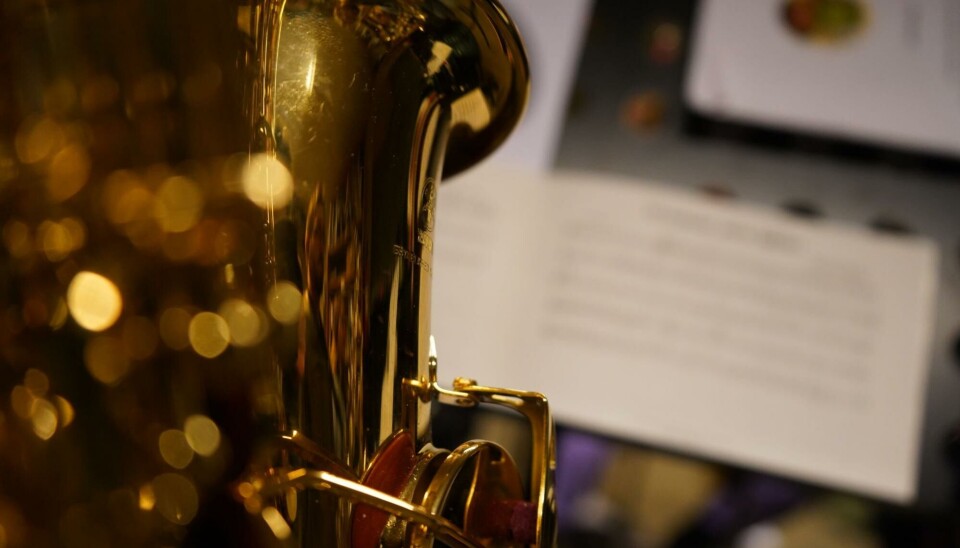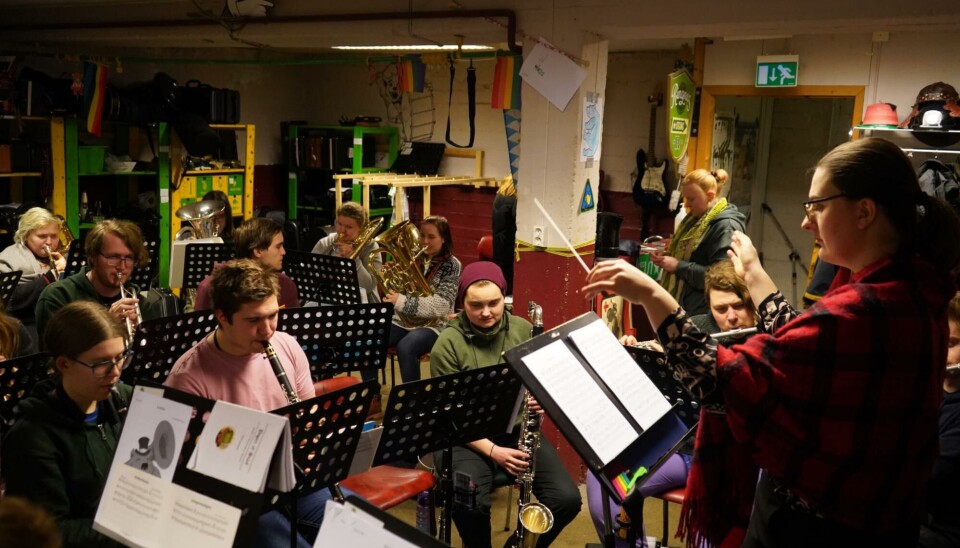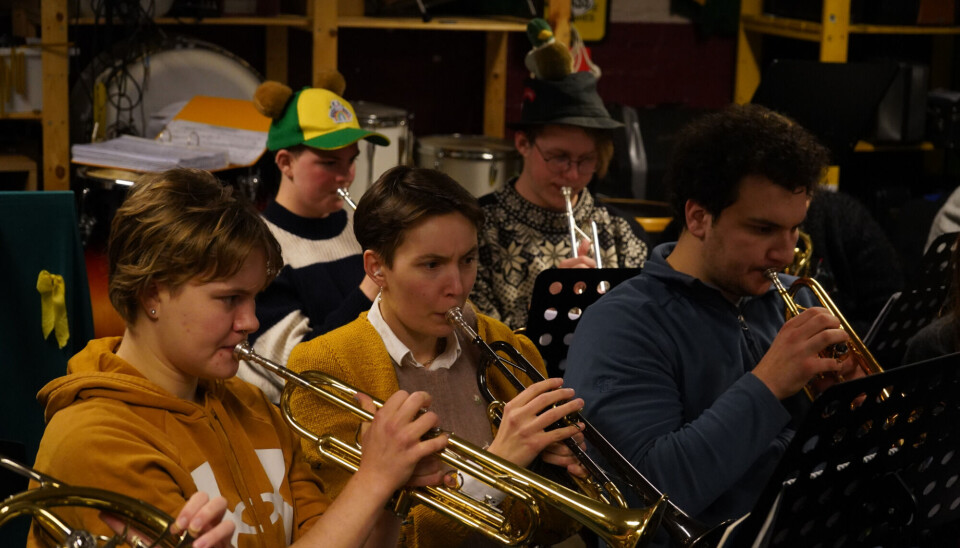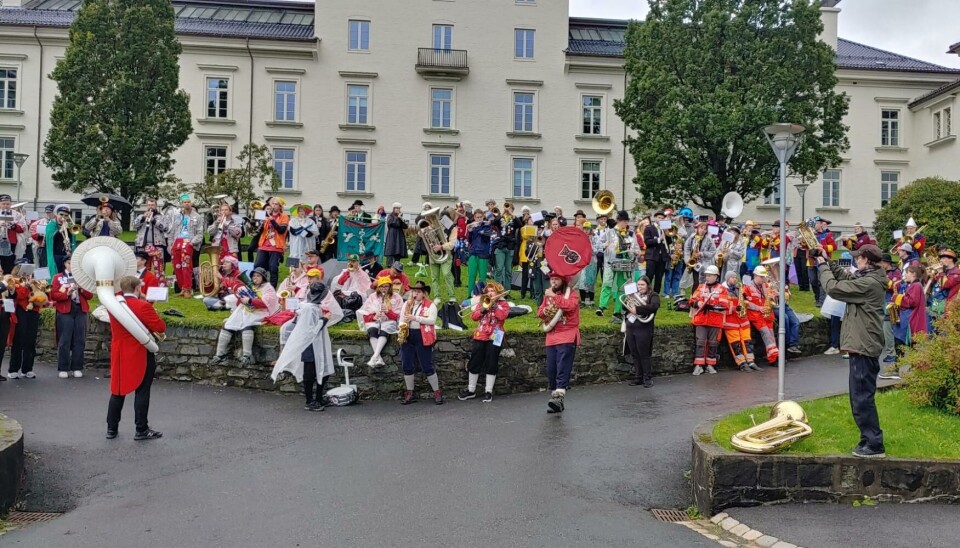#StudentLife

I Played Music in Front of the Prime Minister of Norway
…because I was part of a student orchestra in Oslo! Student orchestras are a wonderful Scandinavian tradition, so here is everything you need to know about it.
Yes, I played saxophone in front of Norway’s Prime Minister, Jonas Gahr Støre! It was a Thursday morning in early September, and the University of Oslo was hosting a government press conference dedicated to artificial intelligence and digital security. The Student Orchestra Biørneblæs was invited by UiO to to welcome the Prime Minister and accompanied his entry in the room.
Our orchestra was a small group of musicians, no more than a dozen, probably because most of the students had classes at 10 am on a Thursday. All of us were wearing the orchestra’s official colours: black, yellow, and green. I had a black jacket on with a yellow T-shirt, which I pulled out of a pile of random clothes in our rehearsal room back in the Physics building at Blindern, and green trousers, way too large for me (but I fixed them with an electric cable I stumbled upon earlier).
I, personally, didn’t know that the Prime Minister would be at the event, and I learned about it only ten minutes before he arrived. On top of that, I had just one rehearsal with the orchestra and didn’t know any of the songs from the repertoire – but they asked me to come anyway. My playing was approximative at best, and I mostly did playback and relied on the people who knew the music – it was “The Bare Necessities” from The Jungle Book, because we play it at almost every gig and rehearsal. I enjoyed it, as did the rest of the orchestra and, or so it seemed, the Prime Minister.
I joined Biørneblæs in late August, as the autumn 2023 semester started. I discovered them at the association day in OsloMet, where I’m doing my exchange semester. I've been playing music for 13 years already, first drums and now saxophone. However, I was on a kind of music break during the past two years, mostly due to COVID and lockdowns, and also because of my studies – I needed to move 600 km away from my hometown. The student orchestra was the best opportunity for me to enter the musical world again and meet new friends who shared the same passion as me. The atmosphere at Biørneblæs was very inclusive, no restriction based on the music level existed. You could, basically, come as you were, with what you knew (or didn’t), and so I did.

Playing to have fun
This is maybe what a student orchestra is in Norway: “The spirit is to play just for fun,” explains Markus Frislid, CEO of Biørneblæs in Oslo. “Not every time it sounds super great, but we have fun playing, and it's in a way funny when we mess up.” It is in Trondheim where the biggest student orchestra of Norway is located: “We have around 80 members playing each semester,” tells Inge Grelland, musical leader and the new conductor of Dei Taktlause and there as well, “professionalism” is not the keyword: “It's new, I haven't done much before. But I realised that people don't really care about what you really do as a conductor. We are all there to play and have fun.”
Having fun with everyone who wants to join… even people that do not know how to play any instruments! I tried to teach some of the newest members of the orchestra the basics of saxophone in a few dozen minutes and then they integrated the group with everyone. They then learned by discovering new things in every song. Inge Grelland explains: “Most people who are coming obviously have played in school orchestras before and come from that environment, but we have a few that had a couple friends of current members who decided to join in, who never played anything. So usually they get some help from the others in the same instrument group.” And I really did see some people learn from scratch how to play saxophone or clarinet!
Vanessa, an exchange student from Germany, studying maths, joined in September with one goal – to learn how to play an instrument: “I’ve been playing the recorder for 16 years, but besides that I haven’t played any other instrument.” She chose tenor saxophone. After one semester, Vanessa feels that “It is still difficult to play, especially new songs. Besides that, it is fun and I’m happy to be a part of the orchestra.”
The main objective for Holly, a British student in literature, was to make some friends. “I played the viola before but not in a few years, and I knew that I did not want to play it again,” she says. “I was offered to learn something new, a clarinet, and I was very excited.” At the end of the semester, Holly feels that she learned a lot, and not just about the clarinet: “The chats we have after rehearsals are always filled with stories and little bits of Norwegian culture.” And she reached her goal: “I definitely formed strong friendships.”

An old tradition
Student orchestras are an old, unique Scandinavian tradition. According to Studentorkesterhistoria, they seem to have first appeared in Sweden during the 19th century. “Hornboskapen from Uppsala, formed in the 1840s, is generally regarded as the first student orchestra,” says the blog. They then expanded to all Scandinavia during the 20th and especially during the 1950s and 1960s (Biørneblæs in Oslo was created in 1971). Since then, a lot of customs have developed.
Across all orchestras in Scandinavia, different signature songs are chosen to be played during gigs. In Dei Taktaluse, for example, according to Inde Grelland, “We have stuff like pop music, there's some game music, too, but film scores come back a lot.”
One of the main signatures of student orchestras was introduced in 1954 – colourful uniforms of which they are very proud. In my orchestra, Biørneblæs, we stick to green (someone once got a lot of trousers from the KIWI supermarket), yellow (even the current board doesn’t know why) and black (the classic colour of blazers) with a lot of different accessories such as funny hats, patches, or medals. Most of these accessories musicians get for each SMASH they participate in.

Every orchestra can defend its colours in different Student Orchestra festivals. In Norway, the main one is SMASH (Societé Musicae Academique de Schlaag et Hoorn). “It's a weekend where all the student orchestras [around 20 in Norway from Oslo, Ås, Bergen, Trondheim, Kristiansand, and Tromsø] come together for a weekend basically to just party, play music, and have fun,” explains Markus Frislid. “We start the Friday with an obstacle course where we get divided into teams to get to know each other and build a team spirit across the student orchestras. Then we have the concert and also a pub to pub where we play when we're walking between the pubs to make some noise in the city we're in,” he adds.
Each semester, SMASH rotates across the different biggest cities of Norway (Oslo, Ås, Bergen, Trondheim, and Kristiansand). In spring 2024, the festival will take place in Kristiansand. But get ready for next autumn, since Oslo is hosting SMASH for a weekend of festivities! The precise dates are not decided yet, but “It will most likely be at the end of September,” estimates Markus Frislid.

Music, a real international language
Talking about playing altogether, we usually present music as an international language. And it is true! Most of the rehearsals are in English to make sure that everyone can adjust their playing to get better results. “It's usually a mix of Norwegian and English,” admits Inge Grelland. “We help students to learn Norwegian stuff if they want, but I don't have anything against switching to English to explain things when it's needed.”
So many nationalities are represented in student orchestras. Indeed, international students, as I am, contribute to the orchestras every semester. It is, by the way, a bit confusing at the very beginning to relearn all the vocabulary of music in another language, but we get used to it. It is then so impressive, when we finally all get a sheet of paper with music notes written on it and everyone understands it the same way! With the same instrument, reading on the same paper, whereas you are Norwegian, French, German, Japanese, Italian, or from wherever in the world, it is the same thing that will get out of your instrument, and it will be in harmony with the rest of the orchestra. This is always such a magical moment for me!

If you want to see this magical process, enjoy live music – just find the orchestra of your city! In Oslo, the main one, accessible for every student, is Biørneblæs at UiO. The others are linked to a specific faculty (Corpus Juris for the law faculty and Medicinsk Paradeorchæster for the medicine faculty) or a specific student accommodation (Blindern Haarn oc Blaese Orchaester for the Blindern Studenterhjem, or Blindern Studenthouse).
Follow orchestras on social media to know everything about their events. You can come to see them during rehearsals (every Thursday at 19h at the Physics building, Blindern, for Biørneblæs) or at any gigs, to join the orchestra (nothing is required, instruments can be borrowed), or just to assist as a spectator once.
We play music for many reasons: for our own pleasure, to make everyone enjoy the songs, to sing and dance together. You might also see student orchestras at big student events, or during the Constitution Day in Norway, the 17th of May. It is a tradition that orchestras take part in the kindergartens’ parade and the national day’s festivities.
































